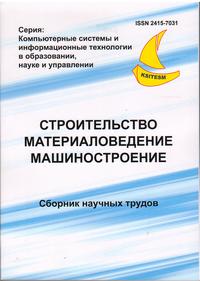The possibility of using thermal mark for estimation flow meters in water heating system
Keywords:
thermal mark, water heating system, flow meter, experimental estimation, hydraulic resistances, project managementAbstract
Abstract. Purpose. To determine hydraulic parameters of water heating systems during operation the identification of hydraulic circuit is applied. The mathematical model of the hydraulic circuit is the model with concentrated parameters. The parameters of the hydraulic circuit are: flow rates at circuit jets, flow rates at circuit edges of the graph, pressure at circuit jets and difference pressure at circuit edges, hydraulic resistances of circuit edges. Identification of the hydraulic circuit is performed by the method of “mathematical flowmeter”. One of the methods for measuring liquid or gas flows is a mark method, and of the possible marks in the heating system is acceptable to use thermal mark. The purpose of the work is to confirm experimentally the possibility of using thermal marks to assess water flow in the pipe water heating system. Methodology. There are measuring of some parameters of the circuit and comparison of calculated and experimental data. Experimental flow rates are determined by the mark method. Thermal mark is proposed for velocity marking at water heating systems. An experimental installation was developed for detection capabilities of thermal marks. The typical dimensions of the tube - diameter, wall thickness and length of the elementary pipe section – are typical for similar sized heating systems. Detection of thermal mark was fixed mounted thermal sensors on the outside of pipes. Findings. Fixing signals thermal sensors, which are mounted on the outside of pipes and fix the water flows inside the tubes showed that the speeds typical of water for water heating systems use thermal mark is perfectly acceptable for the estimation of water flow. Originality. It is shown that the estimation of water flows for water heating systems by using thermal marks can be used to refine the parameters of hydraulic modes of heating systems in operation. Practical value. Using thermal marks in the water heating system will significantly improve the accuracy of identification of the heating network parameters during operation. Identification of hydraulic resistances of water heating systems during exploitation is proposed as a stage of project management.
References
Evdokimov A.G. and Dubrovskiy V.V. Potokoraspredelenie v inzhenernykh setyakh [Flow in engineering networks]. Moscow, Stroyizdat Publ., 1987, 199 p. (in Russian).
Irodov V.F. and Kasin A.N. Identifikaciya gidravlicheskih soprotivleniy truboprovodnih setey metodom evolucionnogo programirovaniya [Identification of water supply systems hydraulic resistance by evolutionary programming method]. Izv. Vuzov. Neft i gas [Proc. Higher education. Oil and gas], 1982, no. 10, pp. 64–68. (in Russian).
Irodov V.F. and Barkovskiy A.M. Matematicheskoe obespechenie identifikatsii parametrov vodyanykh sistem otopleniya v usloviyakh ekspluatatsii [Identification water heating parameters software under operating conditions]. Matematichne ta programne zabezpechennya intelektualnih system [Mathematical and software of intellectual systems]. Dnepropetrovsk, 2012, pp. 128–129. (in Russian).
Kremlevskiy P.P. Raskhodomery i schetchiki veshchestv [Flow meters and substances counters]. Kiev, Politekhnika Publ., 2004. 412 p. (in Russian).
Merenkov A.P., Svetlov K.S. and Hasilev V.Ya. Metody i sredstva dlya upravleniya ekspluatatsiey i razvitiem truboprovodnykh sistem [Methods and resources for operation controlling and developing of pipeline systems]. Oprimizaciya I upravlenie v bolshih systemah energetiki [Optimization and management of large-scale power systems], 1970, pp. 60–80. (in Russian).
Merenkov A.P. and Hasilev V.Ya. Teoriya gidravlicheskikh tsepey [Hydraulic circuit theory]. Moscow, Nauka Publ., 1985. 279 p. (in Russian).
Merenkov A.P., Novitsky N.N. and Sidler V.G. Direct and inverse problems of flow distribution in hydraulic. Soviet. Techno. Rev. Sec. Ai Energy Rev. Harwood Academic Publishes, U.S.A., 1994, issue 7, Part 4, pp.33–95.
Downloads
Published
Issue
Section
License
Редакція Видання категорично засуджує прояви плагіату в статтях та вживає всіх можливих заходів для його недопущення. Плагіат розглядається як форма порушення авторських прав і наукової етики.
При виявлені у статті більш ніж 25% запозиченого тексту без відповідних посилань та використання лапок, стаття кваліфікується як така, що містить плагіат. У цьому випадку стаття більше не розглядається редакцією, а автор отримує перше попередження.
Автори, в статтях яких повторно виявлено плагіат, не зможуть публікуватися в усіх журналах Видавництва ДВНЗ «Придніпровська державна академія будівництва та архітектури».
Автори, які публікуються у цьому журналі, погоджуються з наступними умовами:
- Автори залишають за собою право на авторство своєї роботи та передають журналу право першої публікації цієї роботи на умовах ліцензії Creative Commons Attribution License, котра дозволяє іншим особам вільно розповсюджувати опубліковану роботу з обов'язковим посиланням на авторів оригінальної роботи та першу публікацію роботи у цьому журналі.
- Автори мають право укладати самостійні додаткові угоди щодо неексклюзивного розповсюдження роботи у тому вигляді, в якому вона була опублікована цим журналом (наприклад, розміщувати роботу в електронному сховищі установи або публікувати у складі монографії), за умови збереження посилання на першу публікацію роботи у цьому журналі.
- Політика журналу дозволяє і заохочує розміщення авторами в мережі Інтернет (наприклад, у сховищах установ або на особистих веб-сайтах) рукопису роботи, як до подання цього рукопису до редакції, так і під час його редакційного опрацювання, оскільки це сприяє виникненню продуктивної наукової дискусії та позитивно позначається на оперативності та динаміці цитування опублікованої роботи (див. The Effect of Open Access).

